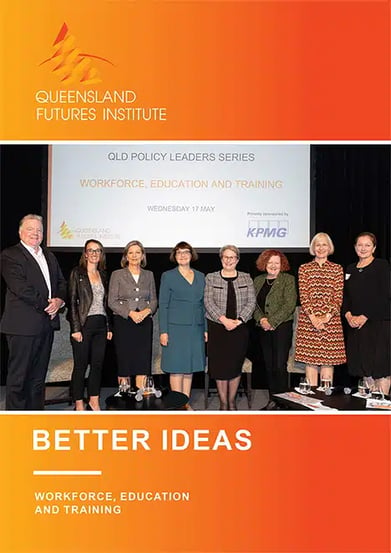
|
Professor Helen Bartlett
- The University of the Sunshine Coast is the youngest and one of the fastest growing public universities in Australia, with campuses located from North Brisbane at Petrie, Moreton Bay and up to the Fraser Coast. 90% of our students are employed within three months of graduating and around seven in ten of our students will go on to live and work in the regions. This provides a strong regional perspective on the education sector.
- The challenges that we are currently experiencing relate to the changing world that we are in – with shifting expectations from students, businesses and industry. This, in addition to a very challenging policy and funding environment and increasing costs, requires an agile response from the education sector.
- The sector is currently undergoing a review which is being conducted by the Commonwealth Government and will be completed by the end of the year. This Accord process is a once-in-a-generation opportunity to set the direction for higher education for the coming decades.
- Many other opportunities are emerging through this process – so it is critical for the sector to help shape the future of the sector. This can be achieved by engaging and interfacing with business and industry to unlock further employment and training opportunities.
- 50% of Queensland’s population lives outside of the Brisbane statistical area but is disadvantaged through low education participation rates – which are sometimes half that of the greater Brisbane area. It is critical to provide education and training opportunities to these communities.
|
|

|
Professor Carolyn Evans
- Griffith University has campuses running from Brisbane through Logan and down to the Gold Coast. We are seeing extraordinary demand for a highly skilled, trained and educated workforce, and we are facing a major challenge in meeting this demand across multiple industries.
- Businesses, universities and TAFE have done things the same way for a long time, but there is a growing impetus to work more collaboratively to create opportunities for students and employers. This may include new ways of delivering degrees, apprenticeships and integrated work and study options to people who are already in the workforce.
- When employment levels are high, people tend not to go to university, so universities must think of new ways of keeping domestic students in the sector. The education sector needs the help of employers to find and train the highly skilled workforce they require. There is an opportunity for existing staff, educational institutions and employers to work together to ensure staff are both fit for the workforce and also retained. Industry should be encouraged to engage in this given the high demand for highly skilled workers and high costs to employ and retain staff.
- A recent LinkedIn study found that 60% of new employees are looking for a new job opportunity outside their employer within three years of starting a job. This drops to 40% for the employers who are highly focused on internal mobility and professional development. This shows the higher potential return of investment in retention and education opportunities, compared to returns from spending on hiring.
- An example of investment in current workforce rather than hiring is in Griffith’s recent work with the Commonwealth Bank of Australia to upskill 3,000 staff on financial crime detection and investigation. This has brought together a multidisciplinary team from Griffith to develop a particular specialisation for CBA which strongly positions these employees and the bank as an employer. This reflects strong investment in its own capabilities which will likely result positively on retention in this area, in addition to providing a competitive advantage compared to other banks.
- Finally, we need to stop wasting human talent and maximise participation from the working age population. Less than 50% of disabled people of working age are employed. While educational institutions have improved the opportunity for people with disabilities, we need to do better to support these people in gaining employment. We should also work on having more women in the STEM areas, ensure opportunities for our migrant and our refugee population, and for international students with post-study work rights. Many of these people are often very talented and have strong global networks, and yet these demographics are underrepresented in employers’ talent pools.
- We are now at a critical turning point and have an opportunity to work more closely together to achieve better outcomes for our businesses, for our educational institutions and most importantly for Queensland and for Australia.
|

|
Professor Geraldine Mackenzie
- The University of Southern Queensland has campuses at Toowoomba, Ipswich and Springfield. We are at a critical point in our history and have an opportunity through the Accord process to address the fundamental problems that we are currently facing in funding higher education.
- The National Skills Commission have recently outlined a five-year projection showing that 9 in 10 new jobs are projected to require post-school qualifications. We are currently not meeting this demand.
- Taking a regional perspective, we have long-term underrepresentation in higher education. The participation rate is even lower when adding in other factors such as those students with a disability.
- Remote students have less than half the participation rate of other students, and regional students have 70-80% of the participation rate of other students. Considering the current demand for further education in the workforce, this will start reflecting as a massive problem through underemployment. This gap will impact regional communities as well as Australia as a whole.
- We know that 70% of students who complete their studies in regional areas stay in those regional communities. We need to boost education outcomes for regional communities and address the regional skills shortages we are currently facing, preventing brain drain from the regions into the cities.
- The biggest challenge we are currently facing to address these issues is building relationships between universities, government and industry, and supporting greater collaboration required to address the above problems. We need to be able to move much more quickly to meet the needs of industry. While this has been possible to some degree before, the current Accord process must better support the sector to do this.
|

|
Professor Margaret Sheil AO
- QUT has two major campuses at Gardens Point and Kelvin Grove, and seven distributed sites around Queensland as far as Mackay. QUT strongly engages with business, both in research and in teaching, which has historically been a strength of the university. This is continued through the design of programs in integrated learning and engagement with industry professionals in our courses.
- We must do better to leverage the existing skills and talent in an underemployed international graduate workforce or from those who cannot find the right role. So often, these people are highly educated and have immigrated from overseas either for work or education and find themselves driving Ubers. We must try harder to create opportunities for these people and in doing so, we will address labour shortages and create more diversity in the workforce.
- We can also be more collaborative with industry by aligning degrees or education programs with professional accreditation, as these are not moving as quickly as we need to continue meeting demand for highly skilled professionals. For example, professions accredit programs based on headcount rather than the load that students are undertaking. We know that given the current high cost of living, students are taking on less than full-time loads, which is resulting in vacancies in areas that are experiencing workforce shortages. This must be addressed going forward.
|

|
Professor Deborah Terry AO
- The University of Queensland is not alone in addressing the significant challenges the sector is currently facing. Considering the Queensland Government’s Jobs Plan, which indicates a need for 300,000 skilled workers in the next few years, we are facing a significant skills gap, and must better attract talent and address the regional maldistribution of the workforce.
- While this is a local issue, looking globally shows widespread shifts and a rapidly changing nature of work – which will continue to place pressure on the workforce. For example, a recent Goldman Sachs report found that generative AI would impact 300 million jobs, many of which are white collar. The World Economic Forum has also recently explored the future of work and found that 23% of jobs will change by 2027, 44% of skills will be disrupted, and 60% of workers will require retraining or upskilling by 2027.
- This is driven by two rapid changes – advancements in technology and sustainability. These may lead to an overall loss of existing jobs, but at the same time, there will be a net increase in jobs as a consequence of two industrial revolutions around these rapid changes.
- We must work harder to create opportunities for those who do not currently have access to education, across higher and tertiary education and the VET sector, at the levels we see in metropolitan areas. The Accord presents an opportunity to achieve this.
- We must also work in partnership with government and industry to co-design what we need for the future, training for new roles and in new areas such as in sustainability and health. This must not only be for entry levels; we must empower workers at all stages of their lives through upskilling and reskilling to ensure people and communities are not left behind and can remain productive and competitive.
|

|
Ana Rodger
- TAFE Queensland has 130,000 students and is celebrating 140 years of educating and working seamlessly with industry. A great example of this collaboration is the Mitsubishi BHP Alliance “Future Skills Partnership” where TAFE Queensland has developed and is delivering autonomous technology solutions.
- This year, there have been 34,000 fee-free places for TAFE Queensland, which has helped to change the narrative and perception of TAFE. This was achieved because of supportive government policy which is significantly shifting the sector to reflect the value that VET plays in the national economy. The fee-free places are part of an interim one year agreement which will be followed by a five-year National Skills Agreement to support training places related to significant skills gaps across Australia.
- Reskilling and upskilling represent incredible opportunities for the sector as the nature of work changes. For example, TAFE has worked with the hybrid and electric vehicle industry to provide training for technicians and avoid having this talent drop out of the system.
- A significant challenge is providing training while people are in the workforce, and unable to cease employment to undergo upskilling. This was somewhat addressed through Covid, as methods of delivery changed and the sector introduced virtual delivery, and both virtual and augmented reality, enabling more efficient delivery of training. This challenge must urgently be addressed. If students are unable to undertake the required upskilling for their jobs, they will not be productive enough in the workforce and this will adversely impact industry.
- Given the cost and pace of technological development and resources required to provide this training, it is critical that industry works with training providers in partnership to ensure that training can be provided at an affordable cost.Audience Question
|




















